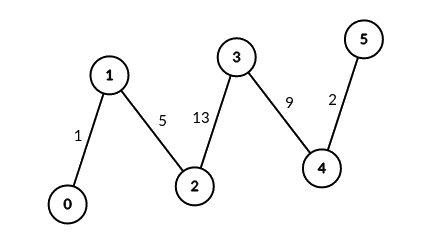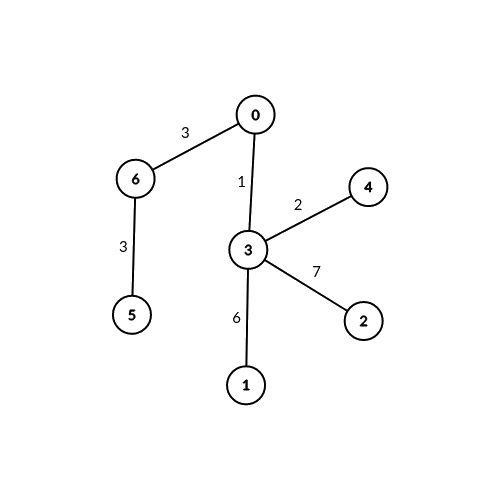阅读量:3
【LetMeFly】3067.在带权树网络中统计可连接服务器对数目:枚举根
力扣题目链接:https://leetcode.cn/problems/count-pairs-of-connectable-servers-in-a-weighted-tree-network/
给你一棵无根带权树,树中总共有 n 个节点,分别表示 n 个服务器,服务器从 0 到 n - 1 编号。同时给你一个数组 edges ,其中 edges[i] = [ai, bi, weighti] 表示节点 ai 和 bi 之间有一条双向边,边的权值为 weighti 。再给你一个整数 signalSpeed 。
如果两个服务器 a ,b 和 c 满足以下条件,那么我们称服务器 a 和 b 是通过服务器 c 可连接的 :
a < b,a != c且b != c。- 从
c到a的距离是可以被signalSpeed整除的。 - 从
c到b的距离是可以被signalSpeed整除的。 - 从
c到b的路径与从c到a的路径没有任何公共边。
请你返回一个长度为 n 的整数数组 count ,其中 count[i] 表示通过服务器 i 可连接 的服务器对的 数目 。
示例 1:

输入:edges = [[0,1,1],[1,2,5],[2,3,13],[3,4,9],[4,5,2]], signalSpeed = 1 输出:[0,4,6,6,4,0] 解释:由于 signalSpeed 等于 1 ,count[c] 等于所有从 c 开始且没有公共边的路径对数目。 在输入图中,count[c] 等于服务器 c 左边服务器数目乘以右边服务器数目。
示例 2:

输入:edges = [[0,6,3],[6,5,3],[0,3,1],[3,2,7],[3,1,6],[3,4,2]], signalSpeed = 3 输出:[2,0,0,0,0,0,2] 解释:通过服务器 0 ,有 2 个可连接服务器对(4, 5) 和 (4, 6) 。 通过服务器 6 ,有 2 个可连接服务器对 (4, 5) 和 (0, 5) 。 所有服务器对都必须通过服务器 0 或 6 才可连接,所以其他服务器对应的可连接服务器对数目都为 0 。
提示:
2 <= n <= 1000edges.length == n - 1edges[i].length == 30 <= ai, bi < nedges[i] = [ai, bi, weighti]1 <= weighti <= 1061 <= signalSpeed <= 106- 输入保证
edges构成一棵合法的树。
解题方法:枚举根
枚举每个节点作为c,以c为根,求每个“子树”中有多少节点离c的距离是signalSpeed的总个数(可以通过DFS求出)。
c / \ * *** ** 假设所有子树中符合要求的节点数分别为[4, 5, 8],则以c为根的总对数为4 * 5 + 4 * 8 + 5 * 8(两两相乘)。
- 时间复杂度 O ( n 2 ) O(n^2) O(n2)
- 空间复杂度 O ( n ) O(n) O(n)
AC代码
C++
class Solution { private: vector<vector<pair<int, int>>> graph; int signalSpeed; int dfs(int from, int to, int cntDistance) { int ans = cntDistance % signalSpeed == 0; for (auto [nextNode, nextDistance] : graph[to]) { if (nextNode == from) { continue; } ans += dfs(to, nextNode, cntDistance + nextDistance); } return ans; } public: vector<int> countPairsOfConnectableServers(vector<vector<int>>& edges, int signalSpeed) { // init graph.resize(edges.size() + 1); this->signalSpeed = signalSpeed; for (vector<int>& edge : edges) { graph[edge[0]].push_back({edge[1], edge[2]}); graph[edge[1]].push_back({edge[0], edge[2]}); } // calculate vector<int> ans(edges.size() + 1); for (int c = 0; c < ans.size(); c++) { vector<int> ab; // c为根的每个边上有多少ab节点 for (auto [to, distance] : graph[c]) { ab.push_back(dfs(c, to, distance)); } for (int i = 0; i < ab.size(); i++) { for (int j = i + 1; j < ab.size(); j++) { ans[c] += ab[i] * ab[j]; } } } return ans; } }; Python
# from typing import List class Solution: def dfs(self, from_: int, to: int, cntDistance: int) -> int: ans = 0 if cntDistance % self.signalSpeed else 1 for nextNode, nextDistance in self.graph[to]: if nextNode == from_: continue ans += self.dfs(to, nextNode, cntDistance + nextDistance) return ans def countPairsOfConnectableServers(self, edges: List[List[int]], signalSpeed: int) -> List[int]: # init self.signalSpeed = signalSpeed graph = [[] for _ in range(len(edges) + 1)] for x, y, d in edges: graph[x].append((y, d)) graph[y].append((x, d)) self.graph = graph # calculate ans = [0] * (len(edges) + 1) for c in range(len(ans)): ab = [] for to, distance in graph[c]: ab.append(self.dfs(c, to, distance)) for i in range(len(ab)): for j in range(i + 1, len(ab)): ans[c] += ab[i] * ab[j] return ans 同步发文于CSDN和我的个人博客,原创不易,转载经作者同意后请附上原文链接哦~
Tisfy:https://letmefly.blog.csdn.net/article/details/139456087
